Archaeologist Discovered The Ancient Dinosaur Figurines of Acámbaro in Mexico

Archaeologist Discovered The Ancient Dinosaur Figurines of Acámbaro in Mexico
In the late 1960s, American detective author Erle Stanley Gardner stood before a collection of over 30,000 figurines. He had found out about this collection many years ago and felt a deep sense of astonishment when seeing it in person at this modest house in the small rural village of Acámbaro in the state of Guanajuato, Mexico. Gardner, the writer who came up with great titles like The Case of the Black Cat and Granny Get Yours Gun, and who created such memorable character as Perry Mason, Della Street and Lester Leith had a real-life mystery in front of him.

The figurine was fantastic and seemingly out of place. Many of them featured people of various races and some 10 % of them looked like our modern depictions of dinosaurs. These dinosaurs were sometime accompanied by humans; some of the figure had dinosaurs wrestling with people or men even riding dinosaurs. Of course, dinosaurs representations in ancient art were unheard of because humans did not coexist with this prehistoric creature.
The creators of Perry Mason, who was considered to be the best selling American author at the time of his death, was asked to examine the collections by a friend, the Harvard educated anthropologist Charles Hapgood, who was one of the many voices chiming in on this controversy at the time. Hapgood knew that Gardners love of sleuthing did not just apply to fiction writing and Gardners many years as a trial attorney would be helpful in solving the mystery of these anomalous figurine.
Over the years the massive collection has been proclaimed to be an elaborate hoax by people in the more traditional field of science and has been shunned by a most mainstream archaeologist. While many have thought that the whole discussion was put to rest years Back, the Acámbaro figures have begun to generate interest again among fringe Researchers, Christian “young earth” proponents, believers in alternative universe theories and those who follow the “New Chronology” writings of Russian Anatoly Fomenko which claim that written history itself has been adjusted over time to fit the agenda of the elites.

Some investigator in more traditional scientific fields has also been recently drawn to these figures once again, as the controversies have become debated online. The figures, which for many year have been literally and figuratively “crated up” and not be available for examinations are now on display for all to see at the Waldemar Julsrud Museum in Acámbaro, Guanajuato.
The story of the Acámbaro figurines begins in 1945. A German merchant named Waldemar Julsrud was riding his horse along the edge of a mountain called El Toro just outside of town. In a dried out riverbed he noticed an unusual parts of clay figurines sticking out of the dirt.
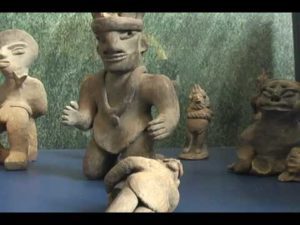
He began digging and found a number of curious figures near the riverbed. Julsrud was already familiar with pre Columbian ceramics as he had one of the largest collection of artifacts from the pre Classic Chupicuaro culture then amassed. While he was not selling hardware, he was digging up or acquiring pieces for his collection and over the years Julsrud became quite the amateur archaeologist.
He had never seen the types of figures that he had Exavated at the base of El Toro, so he asked one of his employes named Odilon Tinajero if he could find more of these figurines for him. Julsrud would pay Tinajero one peso for each figurine brought to him intact or with pieces that were easily put together. Thus began his collection, and over a 5 to 6 year periods, Julsrud gathered over 35,000 of these strange figures.
In 1947 when Julsrud publishes a booklet on his discoveries called Enigmas del Pasado – Enigmas of the Past – the figurines began to receive international attention. In March of 1951, Lowell Harmer, a veteran writer for the Los Angeles Time published an article titled: “Mexico Finds Give Hint of Lost World: Dinosaur Statues Point to Men Who Lived in Age of Reptiles.”
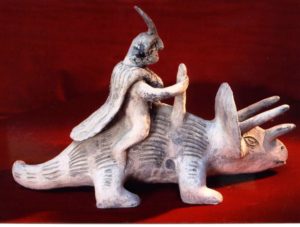
Harmer had visited Acámbaro earlier that year and describes the sheer volume of the collection in Julsrud’s house wrote that the figurines “filled the floors, the tables, and the wall cabinets to overflowing.” The Times writer also wondered in his articles, “How could it be a hoax? Not even in Mexico, where money is so scarce, could anyone afford the labor of these thousands of statues at the low prices Julsrud is paying.”
While seemingly convinced of the collections authenticity, as an objective writer Harmer finished off his article by saying, “I am a writer, not an archaeologists. It will be up to the experts to decides.” In the next few years, the story was picked up by the tabloid press and made it to the magazines specializing in stories of the fanciful and the bizarre. One articles of note appeared in the February/March 1952 issue of Fate magazine titled “Did Man Tame the Dinosaur?” A clear reference to some of the figurines Displaying men roping and riding the creatures.
The following year, 1953, the Mexican government got involves in the Acámbaro mystery. It sent 4 archaeologist from the Instituto Nacional de Antropología e Historia – also called INAH – in Mexico City to investigates.
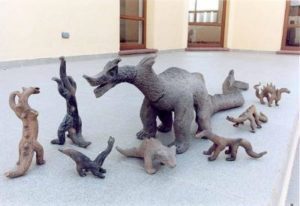
They set up a dig site about a mile from Julsrud’s original discovery location near the base of the mountain called El Toro. They dug a test put going about two meters down and discovered dozens of figurines similar to Julsrud’s, including dinosaurs. INAH then issued a statement that the figurines did correspond to the pre Classic civilizations of the Chupicuaro and could date to as early as 800 BC, but not the dinosaur ones.
The Researchers concluded that even though the dinosaurs were found among other similar figurines in the same archaeological strata, they could not possibly be anything but modern productions as human interaction with dinosaurs were impossible. The Instituto did no further excavations and after the 1950s refused to issue permits for other archaeologist to make new excavations.
On the American side of the border an anthropological organization dedicated to preserving Native American culture, the Amerind Foundation, sent archaeologists Charles Di Peso down to examine the figurines. Di Peso published his findings in volume 18 of the scientific journal American Antiquity in the year of 1953 and in the prestigious Archaeology magazine in the same year.
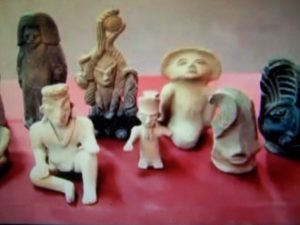
Those who do not believed the figurines to be part of a hoax have pointed out that Di Peso went down to Mexico with a clear bias to expose the figures as fakes and that he did not approach the problem of the figurines with an open mind. Although having the backing of the scientific establishment, Di Peso did make claims that should be scrutinized more closely. For example, in his American Antiquity articles, Di Peso states:
“None of the specimens were marred by patination nor did they possess the surface coating of soluble salts… The figure were broken, in most cases, where the appendages attached themselve to the body of the figurines… No parts were missing. Furthermore, none of the broken surface were worn smooth. In the entire collection of 32,000 specimens no Acambaro shovel, mattock, or pick marks were noted.”

He also stated, “Further investigation revealed that a family living in the vicinity of Acámbaro make this figurine during the winter months when their fields are idle.” In his writing, Di Peso alleged that after the figures were made that they were “planted” in certain location, and in his American Antiquity article he tells the tale of a botched excavation in which he witnessed figurines coming up out of a hole mixed with fresh backfill even fresh manure.
At the end of his articles, Di Peso states, “Thus the investigation ended: it seems almost superfluous to state that the Acámbaro figurine are not prehistoric nor were they made by a prehistoric race who lived in association with Mesozoic reptiles.”
It was not long before Di Peso’s article and claims were shot full of holes. For one, Di Peso only spent two days in Acámbaro and only spent Four hours examining Julsrud’s collection in his home. Di Peso did not set up and conduct an excavation on his own.
He also did not take into consideration that Julsrud’s collection included near perfect figurines purchased from villagers as per Julsrud’s own request. When he began his collection, Julsrud specified that he would pay one peso for each intact figure. There were plenty of pieces and broken figures that did not make it to the over 30,000 in Julsruds home.

The Di Peso article caught the eye of Charles Hapgood, the Harvard trained archaeologist, and friend of Perry Mason creator Erle Stanley Gardner. Hapgood had years of experience and the academic credentials to analyze the Julsrud collection and in 1954 he spent a considerable amount of time in Acámbaro.
Hapgood refuted most of Di Pesos claims point by point. Di Peso claimed that there was no missing pieces. Hapgood found boxes and boxes of parts that could not be put together. Di Peso claimed that there was no discoloring or encrusted dirt on the figures. Hapgood observed that dirt and patination were evident on the figures in spite of Julsruds requirement for cleaned, intact figurines to earn the one peso reward.
Di Peso alleged that there were no pick marks from shoveling on any of the figurine. Hapgood documented the opposite. One of the big element of the hoax proposed by Di Peso was his observation that one of the excavations he witnessed was bringing up fresh dirt from a recent backfill. Hapgood had an answer for this, too. In documenting the excavation procedure, Hapgood wrote, “An important point that cames out was that when the digger stopped work in the middle of excavating a cache, he filled in the hole, to protects it from the many small boys of the neighborhood.
This may have a bearing on the accusation of fraud…” The final point dispelled by Hapgood was that the villager were making the figurines during their “off time” in the winter. The sheer number of figures, both intact and partial, would take many families an incredible amounts of time to produce.
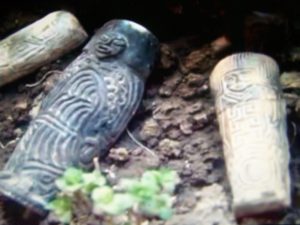
In the next decade, Erle Stanley Gardner would add to this sentiment in his 1969 book about Acámbaro called The Host with the Big Hat. He writes, “I do not believe that it would have been at all possible for any group of people to have made these figures, to have paid for the burro load of wood necessary to ‘fire’ them, take them out and bury them, wait for the ground to resume its natural hardness which would take from one to 10 years, and then ‘discover’ these figures and dig them up, all for a gross price of twelve cents per figure.” Gardner also concluded, “It is absolutely, positively out of the question to think that these artifacts which we saw could have been planted.”
As a scientist, Charles Hapgood knew of the need for the concrete dating of the pieces Utilizing the most up-to-date methods. In 1968 he submitted 3 samples to Isotopes Incorporated of New Jersey for radiocarbon dating.
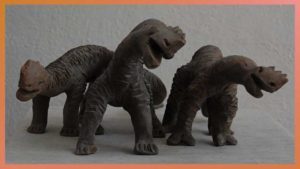
The 1st sample came back as three thousand five hundred and ninety years old, plus or minus 100 years. The 2nd sample came up as six thousand four hundred and eighty years old, plus or minus 170 years. The third sample came up with a date of three thousand and sixty years old, plus or minus 120 years.
To be thorough, Hapgood also submitted four samples to the University of Pennsylvania Museum for thermoluminescent dating, a more accurate way to date pottery. All 4 samples came up with a date of 2,500 BC, plus or minus 190 years. Dr. Froelich Rainey, realizing the importance of accuracy in the dating of these pieces did 18 runs on each of the Four samples and came up with the same results.
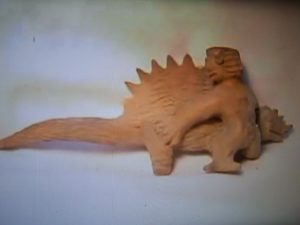
The last attempts to date the figures occurred in 1976. Gary Carriveau and Mark Han also used the thermoluminescent dating technique on Twenty of the figures. All of the samples failed the “plateau test” which indicated that dates obtained from these figurine using high temperature thermoluminescent dating were not reliable and lacked significance. Based on the signal regeneration found in some of the samples, the Carriveau Han team estimated that the figurines were fired sometime in the late 1930s or early 1940s.
So, are these dinosaur figurines authentic archaeological finds of great importance, or are they part of an elaborate hoax? One must ask if this were a hoax, who would benefit from it? Waldemar Julsrud made no Cash from the sales of the figurines or from tourism connected to his collection.

No archaeologist have made names or reputations for themselves because of the dinosaurs of Acámbaro. The Mexican government wants to ignore these figures and prohibits any excavations in the area. Why do they not want more investigation into these figures? As with everything presented on Mexico Unexplained, I encourage you to do your own investigation. Maybe you can finally solve the enigma of the dinosaurs of Acámbaro.